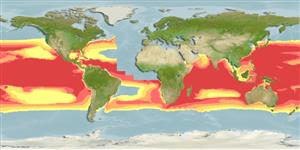Environment: milieu / climate zone / depth range / distribution range
Ökologie
seewasser bathypelagisch; ozeanodrom (Ref. 51243); tiefenbereich 0 - 1000 m (Ref. 74511). Deep-water
Indian and Pacific: widespread in the tropical and subtropical waters. South China Sea (Ref.74511).
Size / Gewicht / Alter
Maturity: Lm ? range ? - ? cm
Max length : 5.0 cm SL Männchen/unbestimmt; (Ref. 4066)
Rückenflossenstacheln (insgesamt): 0; Rückenflossenweichstrahlen (insgesamt): 12-14; Afterflossenstacheln 0; Afterflossenweichstrahlen: 17 - 21. Anal organs 12; mature males with large, single, black-edged supracaudal gland, about 3/4 or more of the supracaudal space; mature females with 2 infracaudal glands; has a larger supracaudal gland than any other species of the genus (Ref. 39633).
Oceanic and mesopelagic. Nyctoepipelagic at the surface (Ref. 4066). Neustonic at 0-150 m at night, 500-700 m during day (Ref. 58302). Oviparous, with planktonic eggs and larvae (Ref. 31442).
Life cycle and mating behavior
Geschlechtsreife | Fortpflanzung | Ablaichen | Eier | Fecundity | Larven
Hulley, P.A., 1986. Myctophidae. p. 282-321. In M.M. Smith and P.C. Heemstra (eds.) Smiths' sea fishes. Springer-Verlag, Berlin. (Ref. 4066)
IUCN Rote Liste Status (Ref. 130435)
Bedrohung für Menschen
Harmless
Nutzung durch Menschen
Mehr Information
ReferenzenAquakulturAquakultur ProfilZuchtlinienGenetikElectrophoresesVererbbarkeitKrankheitenVerarbeitungNutrientsMass conversion
Tools
Zusatzinformationen
Download XML
Internet Quellen
Estimates based on models
Preferred temperature (Ref.
123201): 9.3 - 21.2, mean 14.2 °C (based on 767 cells).
Phylogenetic diversity index (Ref.
82804): PD
50 = 0.5020 [Uniqueness, from 0.5 = low to 2.0 = high].
Bayesian length-weight: a=0.00692 (0.00297 - 0.01609), b=3.13 (2.93 - 3.33), in cm total length, based on LWR estimates for this (Sub)family-body shape (Ref.
93245).
Trophic level (Ref.
69278): 3.2 ±0.28 se; based on food items.
Widerstandsfähigkeit (Ref.
120179): hoch, Verdopplung der Population dauert weniger als 15 Monate. (Preliminary K or Fecundity.).
Fishing Vulnerability (Ref.
59153): Low vulnerability (10 of 100).
